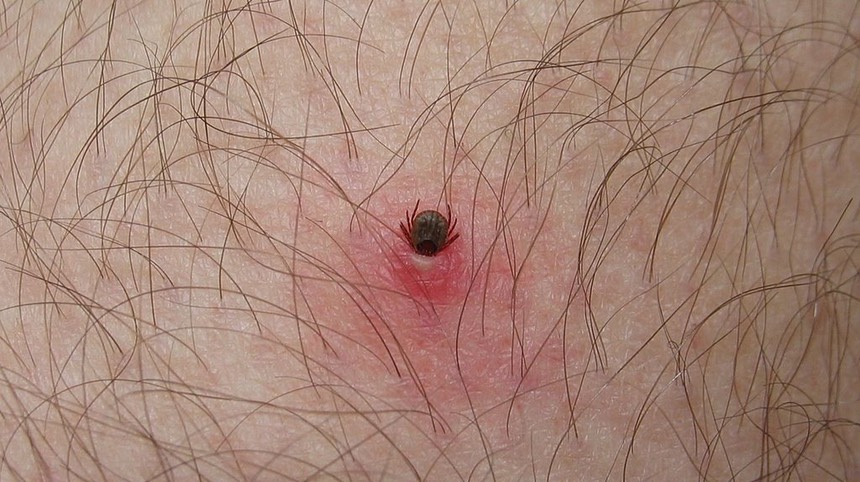Ticks can cause direct physical injury as a result of their biting and bloodfeeding activities. The mouthparts of a tick are composed of two retractable hooked appendages (chelicerae) that pull the skin over a single fixed harpoon-like structure (the hypostome) that, itself, anchors the tick to the skin during feeding. These mouthparts are tiny, and enter just a fraction of a millimeter into the skin. By themselves, they rarely cause more damage than would result by a superficial splinter. You will not likely feel a tick walking on your skin. Furthermore, most tick bites neither are painful nor even noticeable (unless you happen to see the tick or happen to have become sensitized to tick saliva).
The tick produces copious saliva that it injects into the skin during feeding. This saliva contains a potent cocktail of substances that prevents blood clotting at the site and helps the tick feed. The tick’s saliva may cause diverse health effects on a person or animal. Generally, these effects are mild and are limited to local irritation and a bruise-like reaction around the bite site. With repeated exposure to tick bites, a person or pet may develop an allergic sensitivity to the saliva. This may cause the area around the bite to itch and may manifest as a more enhanced skin lesion. Although this itching increases the extent of annoyance, the itching may cause the host to notice the tick and remove it before the tick causes yet greater risk. The longer the tick is attached, the greater the chances that any pathogens within the tick may be transmitted via the tick’s saliva. The saliva from a few kinds of ticks can cause a kind of paralysis that may begin at the lower extremities and proceed to sweep towards the head during a span of hours or days. This phenomenon, termed ‘tick paralysis’ is medically significant. It reverses rapidly once the causative tick has been located and removed. If allowed to proceed, however, tick paralysis can be fatal.
See also: Tick borne disease pathogens
Diagram of tick feeding. Tick A represents a superficial species, such as the American dog tick (Dermacentor variabilis). Tick B represents a more deeply attached species, such as the lone star tick (Amblyomma americanum). The leg bearing section is denoted the podosoma while the head region, the gnathosoma. When removal is attempted, the target region for contact with any removal instrument should be between the podosoma and gnathosoma at the basis capitulum.
shared here with permission of G. Needham
as found in the paper entitled "Evaluation of Three Commerical Tick Removal Tools" published in Wilderness and Environmental Medicine, 9, 137-142 (1998)
and on this webpage

By Denys Williams (Original work; Denys Williams) [GFDL (http://www.gnu.org/copyleft/fdl.html) or CC-BY-SA-3.0 (http://creativecommons.org/licenses/by-sa/3.0/)], via Wikimedia Commons
